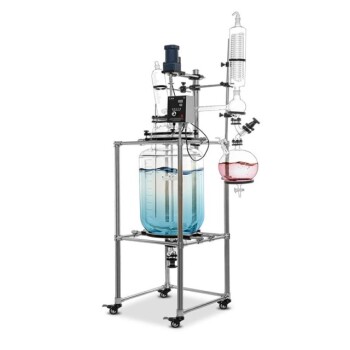Before using a rotary evaporator, it is crucial to follow a series of preparatory steps to ensure safety, efficiency, and proper functioning of the equipment. Key actions include emptying the solvent collection flask to avoid chemical incompatibility, using a bump trap to prevent contamination, and securing all connections. Additionally, personal protective equipment (PPE) must be worn, and the vacuum system, coolant water, and rotation speed should be properly set up. Proper handling of air-reactive materials and rotating parts is also essential to prevent accidents. Finally, the system must be adjusted according to the solvent's properties, and the equipment should be cleaned and maintained after use.
Key Points Explained:

-
Empty the Solvent Collection Flask
- Before starting, ensure the solvent collection flask is empty to prevent accidental mixing of incompatible chemicals. This is critical to avoid chemical reactions that could lead to hazardous situations, such as explosions or toxic gas release.
-
Use a Bump Trap
- A bump trap is essential to prevent the solution from splashing into the condenser. This helps maintain the integrity of the condenser and prevents contamination of the system.
-
Secure Connections
- Use Keck clips or metal clamps to secure the bump trap or flask. This ensures that the components remain firmly attached during operation, reducing the risk of spills or disconnections.
-
Set Up the Vacuum System
- Turn on the vacuum system and connect it to the rotary evaporator. Ensure the system is properly sealed to maintain the required vacuum level for efficient solvent evaporation.
-
Open Coolant Water Intakes
- Open the coolant water intakes to ensure the condenser operates effectively. Proper cooling is necessary to condense the solvent vapors and prevent them from escaping into the environment.
-
Adjust Rotation Speed
- Partially immerse the flask in the water bath and adjust the rotation speed to prevent liquid projection. The rotation speed should be optimized to ensure smooth evaporation without splashing.
-
Wear Personal Protective Equipment (PPE)
- Always wear appropriate PPE, including gloves, goggles, and lab coats, to protect against chemical spills, burns, and solvent vapors.
-
Handle Air-Reactive Materials with Caution
- When working with air-reactive materials under vacuum, extra caution is required. Leaks can draw air into the apparatus, potentially causing violent reactions. Ensure all connections are airtight.
-
Avoid Contact with Rotating Parts
- Keep loose clothing, hair, necklaces, and jewelry away from rotating parts to prevent entanglement, which could lead to burns, cuts, or chemical exposure.
-
Adjust Water Bath Temperature
- Set the water bath temperature below the solvent's boiling point to ensure controlled evaporation. This prevents overheating and potential hazards.
-
Use Liquid Nitrogen or Dry-Ice Condensers for Volatile Solvents
- For highly volatile solvents, use liquid nitrogen or dry-ice condensers to effectively trap and condense the vapors.
-
Release Vacuum and Stop Spinning After Evaporation
- Once the evaporation process is complete, release the vacuum and stop the spinning to safely disassemble the equipment.
-
Clean the Bump Trap and Empty the Receiving Flask
- After use, clean the bump trap and empty the receiving flask to prepare the equipment for the next operation. This ensures the system remains in good working condition.
-
Apply Vacuum Grease
- Before operation, apply vacuum grease to all joints and connections to ensure a proper seal and prevent leaks.
-
Check Tubing Connections
- Ensure all tubing is securely connected to the back of the chiller and the condenser. Loose connections can lead to inefficiencies or safety hazards.
-
Assemble the Machine and Connect Pumps
- Assemble the rotary evaporator according to the schematic diagram and connect the cryopump and vacuum pump. Turn on the cooling chiller and vacuum pump to start the process.
By following these steps and precautions, you can ensure the safe and effective operation of a rotary evaporator, minimizing risks and maximizing efficiency in your laboratory processes.
Summary Table:
| Step | Key Action |
|---|---|
| Empty the Solvent Collection Flask | Prevent chemical incompatibility and hazardous reactions. |
| Use a Bump Trap | Avoid contamination and protect the condenser. |
| Secure Connections | Use Keck clips or metal clamps to prevent spills or disconnections. |
| Set Up the Vacuum System | Ensure proper sealing for efficient solvent evaporation. |
| Open Coolant Water Intakes | Maintain effective condenser operation. |
| Adjust Rotation Speed | Prevent splashing and ensure smooth evaporation. |
| Wear PPE | Protect against spills, burns, and vapors. |
| Handle Air-Reactive Materials | Ensure airtight connections to prevent violent reactions. |
| Avoid Rotating Parts | Prevent entanglement and injuries. |
| Adjust Water Bath Temperature | Set below the solvent's boiling point for controlled evaporation. |
| Use Special Condensers | Use liquid nitrogen or dry-ice condensers for volatile solvents. |
| Release Vacuum and Stop Spinning | Safely disassemble the equipment after evaporation. |
| Clean and Maintain Equipment | Prepare for the next operation and ensure longevity. |
| Apply Vacuum Grease | Ensure proper sealing of joints and connections. |
| Check Tubing Connections | Secure connections to prevent inefficiencies or hazards. |
| Assemble and Connect Pumps | Follow the schematic diagram and connect pumps for operation. |
Ensure your lab's safety and efficiency—contact our experts today for personalized guidance on rotary evaporators!
















